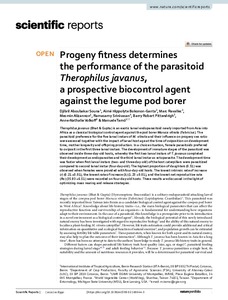| dc.contributor.author | Souna, D.A. |
| dc.contributor.author | Bokonon-Ganta, A. |
| dc.contributor.author | Ravallec, M. |
| dc.contributor.author | Alizannon, M. |
| dc.contributor.author | Srinivasan, R. |
| dc.contributor.author | Pittendrigh, B.R. |
| dc.contributor.author | Volkoff, A.N. |
| dc.contributor.author | Tamo, M. |
| dc.date.accessioned | 2021-06-10T07:38:50Z |
| dc.date.available | 2021-06-10T07:38:50Z |
| dc.date.issued | 2021 |
| dc.identifier.citation | Souna, D.A., Bokonon-Ganta, A.H., Ravallec, M., Alizannon, M., Srinivasan, R., Pittendrigh, B. R., ... & Tamò, M. (2021). Progeny fitness determines the performance of the parasitoid Therophilus javanus, a prospective biocontrol agent against the legume pod borer. Scientific Reports, 11(1), 1-10. |
| dc.identifier.issn | 2045-2322 |
| dc.identifier.uri | https://hdl.handle.net/20.500.12478/7131 |
| dc.description.abstract | Therophilus javanus (Bhat & Gupta) is an exotic larval endoparasitoid newly imported from Asia into Africa as a classical biological control agent against the pod borer Maruca vitrata (Fabricius). The parasitoid preference for the five larval instars of M. vitrata and their influence on progeny sex ratio were assessed together with the impact of larval host age at the time of oviposition on development time, mother longevity and offspring production. In a choice situation, female parasitoids preferred to oviposit in the first three larval instars. The development of immature stages of the parasitoid was observed inside three-day-old hosts, whereby the first two larval instars of T. javanus completed their development as endoparasites and the third larval instar as ectoparasite. The development time was faster when first larval instars (two- and three-day-old) of the host caterpillars were parasitized compared to second larval instar (four-day-old). The highest proportion of daughters (0.51) was observed when females were provided with four-day-old hosts. The lowest intrinsic rate of increase (r) (0.21 ± 0.01), the lowest rate of increase (λ) (1.23 ± 0.01), and the lowest net reproductive rate (Ro) (35.93 ± 6.51) were recorded on four-day-old hosts. These results are discussed in the light of optimizing mass rearing and release strategies. |
| dc.description.sponsorship | CGIAR Research Program on Grain Legumes and Dryland Cereals |
| dc.description.sponsorship | Bill & Melinda Gates Foundation |
| dc.format.extent | 1-10 |
| dc.language.iso | en |
| dc.subject | Biological Control |
| dc.subject | Biological Control Agents |
| dc.subject | Maruca Vitrata |
| dc.subject | Cowpeas |
| dc.subject | Plant Diseases |
| dc.subject | Plant Production |
| dc.subject | Plant Health |
| dc.subject | Progeny |
| dc.subject | Legumes |
| dc.title | Progeny fitness determines the performance of the parasitoid Therophilus javanus, a prospective biocontrol agent against the legume pod borer |
| dc.type | Journal Article |
| cg.contributor.affiliation | International Institute of Tropical Agriculture |
| cg.contributor.affiliation | University of Abomey-Calavi |
| cg.contributor.affiliation | University of Montpellier |
| cg.contributor.affiliation | World Vegetable Center |
| cg.contributor.affiliation | Michigan State University |
| cg.coverage.region | Africa |
| cg.coverage.region | West Africa |
| cg.coverage.country | Benin (Dahomey) |
| cg.coverage.hub | Headquarters and Western Africa Hub |
| cg.researchtheme | Plant Production and Health |
| cg.identifier.bibtexciteid | SOUNA:2021 |
| cg.isijournal | ISI Journal |
| cg.authorship.types | CGIAR and developing country institute |
| cg.iitasubject | Agronomy |
| cg.iitasubject | Cowpea |
| cg.iitasubject | Disease Control |
| cg.iitasubject | Grain Legumes |
| cg.iitasubject | Plant Breeding |
| cg.iitasubject | Plant Diseases |
| cg.iitasubject | Plant Health |
| cg.iitasubject | Plant Production |
| cg.journal | Scientific Reports |
| cg.notes | Open Access Journal; Published online: 26 Apr 2021 |
| cg.accessibilitystatus | Open Access |
| cg.reviewstatus | Peer Review |
| cg.usagerightslicense | Creative Commons Attribution 4.0 (CC BY 0.0) |
| cg.targetaudience | Scientists |
| cg.identifier.doi | https://dx.doi.org/10.1038/s41598-021-88644-3 |
| cg.iitaauthor.identifier | Manuele Tamò: 0000-0002-5863-7421 |
| cg.futureupdate.required | No |
| cg.identifier.issue | 1 |
| cg.identifier.volume | 11 |
| cg.contributor.acknowledgements | We thank the Cooperation and Cultural Action Service (SCAC) of the French Embassy in Cotonou for partial support of DAS (N 898392E). Co-funding was also provided by the CGIAR Research Program on Grain Legumes and Dryland Cereals (GLDC) (DAS, MT and BRP), and the Bill and Melinda Gates Foundation (BMGF) for partial co-funding of the study (OPP1082463 to MT and BRP) and Open Access publication support. We also thank Georg Goergen for the habitus illustration of T. javanus, and Basile Dato for technical assistance with cowpea field installation at the International Institute of Tropical Agriculture (IITA), Benin Station. |

